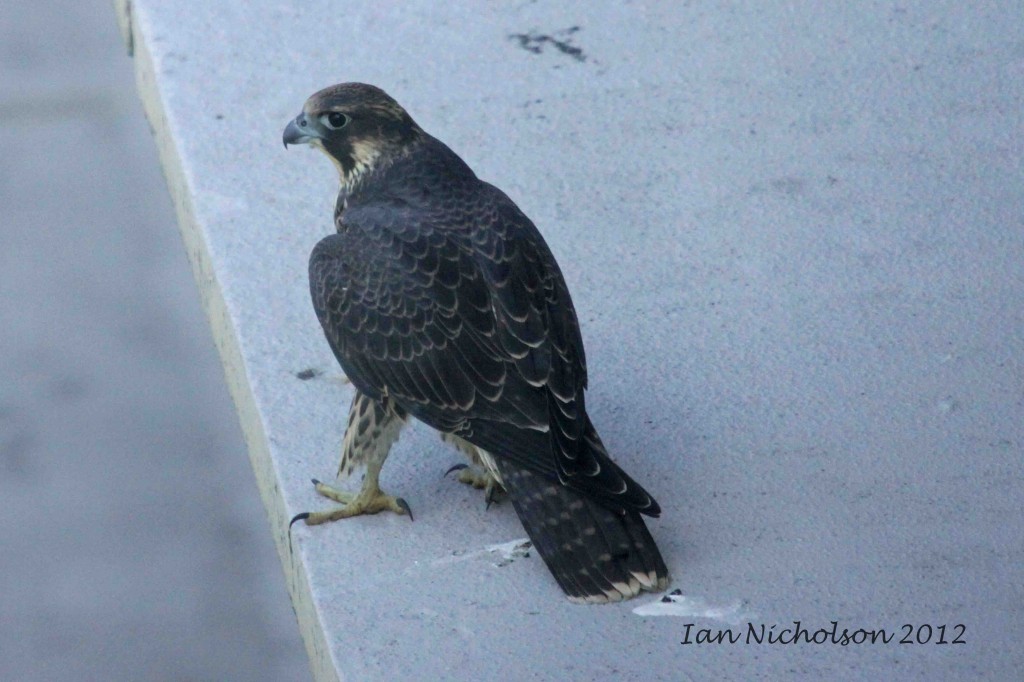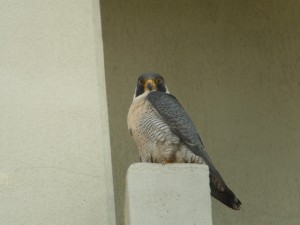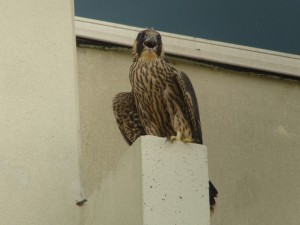The following article appeared in the most recent issue of the Heron Park Herald.
By François Marshall
Ottawa Peregrine Falcon Watch volunteer
A family of raptors discovered this summer in Heron Park caught the Ottawa Peregrine Falcon Watch (OPFW) by surprise and kept volunteers very busy.
The OPFW has been monitoring a pair of Peregrine Falcons at Albert and Lyon since 1997, but the downtown nest failed to produce chicks for the past three years. So it was great news when we learned on June 13 of another nest at the Data Centre at 875 Heron Rd.
By then, two chicks were already furiously flapping their wings, getting ready to take their first flights. There was a scramble to find last-minute volunteers to be on site from sunup to sundown, ready to rescue the young birds of prey if necessary.
The OPFW, a volunteer initiative of the Ottawa Field-Naturalists’ Club under the auspices of the Ontario Ministry of Natural Resources, is responsible for monitoring Peregrine Falcons in the Ottawa area and trying to keep them from harm. When there are young birds, that means stationing volunteers on the ground below the nest, waiting for the fledglings to take their first flights, chasing after them to see where they end up, and rescuing them if they are injured or if they get stranded on the ground, on the street or anywhere else dangerous.
It’s standard practice for the OPFW to name the birds—not surprising when you consider the long hours volunteers devote to watching the magnificent raptors—and the Heron Park Peregrines were no exception. We named the adults Ivanhoe and Rowena (after the hero and his beloved in the Sir Walter Scott novel), while the female chick became Amber and the male chick Data.
Sadly, we learned there were originally four chicks, but two died before the OPFW was notified—one very young chick apparently fell off the nest ledge early on, and the second fell just two days before we learned of the Peregrines. Had we been involved sooner, we might have been there to save the second chick.
Still, despite that rocky start, the rest of the Peregrine family did extremely well. The Data Centre is a relatively safe location because there are no other tall buildings acting as dangerous obstacles, unlike downtown, and there are many ledges were the fledglings can land as they hone their flying skills.
The only major scare came the morning Amber took her first flight, and a volunteer found her being harassed by crows in a tall tree right next to busy Bronson Ave. It is on occasions like this that volunteers need to be particularly aware of the chicks’ actions and get ready for a rescue. After a couple of hours of worrying about Amber ending up in the middle of traffic, and wondering if and how one should retrieve a Peregrine from a tree, we were thrilled when she suddenly flew back to the building on her own.
Data, an ambitious flier from Day One, made volunteers nervous not by landing in dangerous places, but by practising daring aerial acrobatics within a couple of days of learning to fly. The precocious youngster chased his mother when he was hungry, enthusiastically performed barrel rolls and loop-the-loops, and soared so high that we lost sight on him on many occasions. To our great relief, he always came back.
After a 10-day watch, the OPFW decided that Data and Amber were flying well and ready to learn to hunt—a process that would keep them busy for the rest of the summer. On the last day of the watch, we saw Rowena twice drop a pigeon carcass for Amber to catch. Amber failed in the first attempt, but succeeded in the second. This was a first, crucial lesson young Peregrines must learn to eventually catch and kill their own prey. By now, the chicks should have mastered these skills and be ready to fend for themselves.
After this summer, Data and Amber are unlikely to return to the nest site. Instead, they will probably migrate and, if all goes well, eventually establish new territories with their own mates. Ivanhoe and Rowena, meanwhile, will probably spend the winter in the area and nest at the Data Centre again next year—and this time, the OPFW will be ready when the chicks start fledging!
If you haven’t had a chance to see them yet, keep an eye out for the Heron Park Peregrines on the upper ledges of the Data Centre, especially on the south and west sides. You may even see them chasing pigeons—they’re preferred prey—around the high-rise buildings near Bank St., hunting shorebirds along the Rideau River, or perched on other buildings and radio towers in the area.
To learn more about Peregrine Falcons and the OPFW, to sign up as a volunteer and to report sightings and other interesting observations, visit falconwatch.ca.
By volunteering, you will have a chance to witness one of the world’s most iconic animals in action and maybe even save a chick. It’s also a good opportunity for students to log voluntary work hours. We expect the next Falcon Watch to begin around mid-June, but won’t know exactly when until the eggs hatch.









